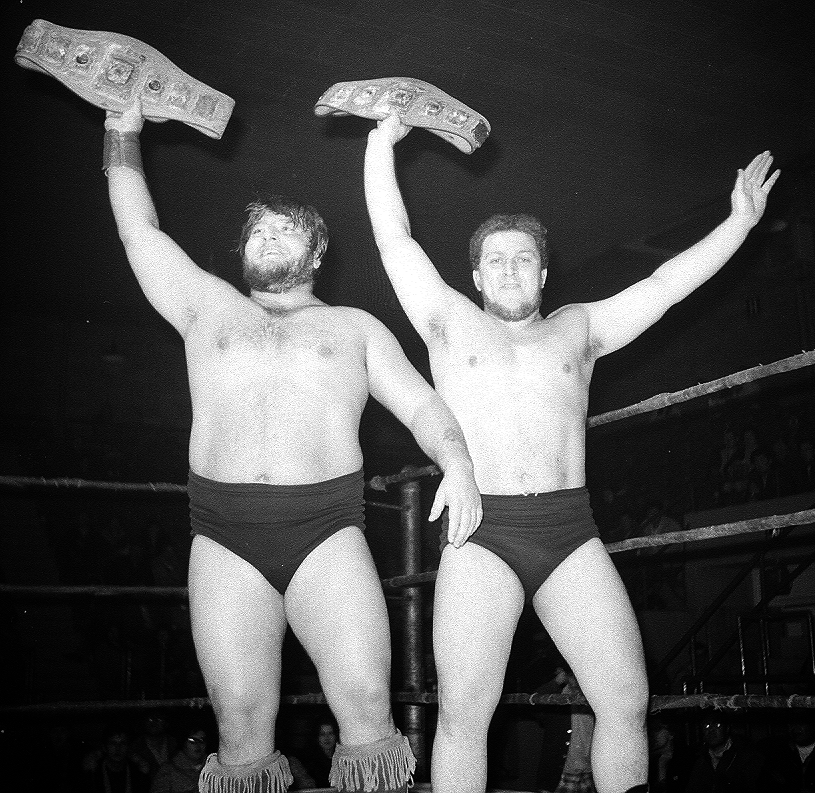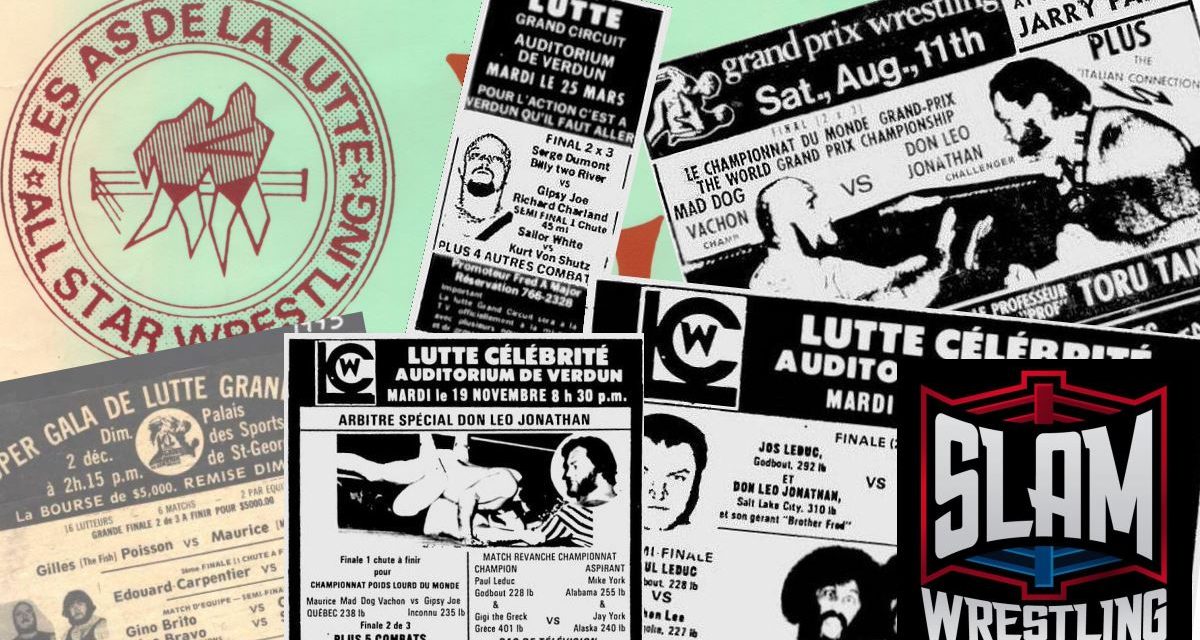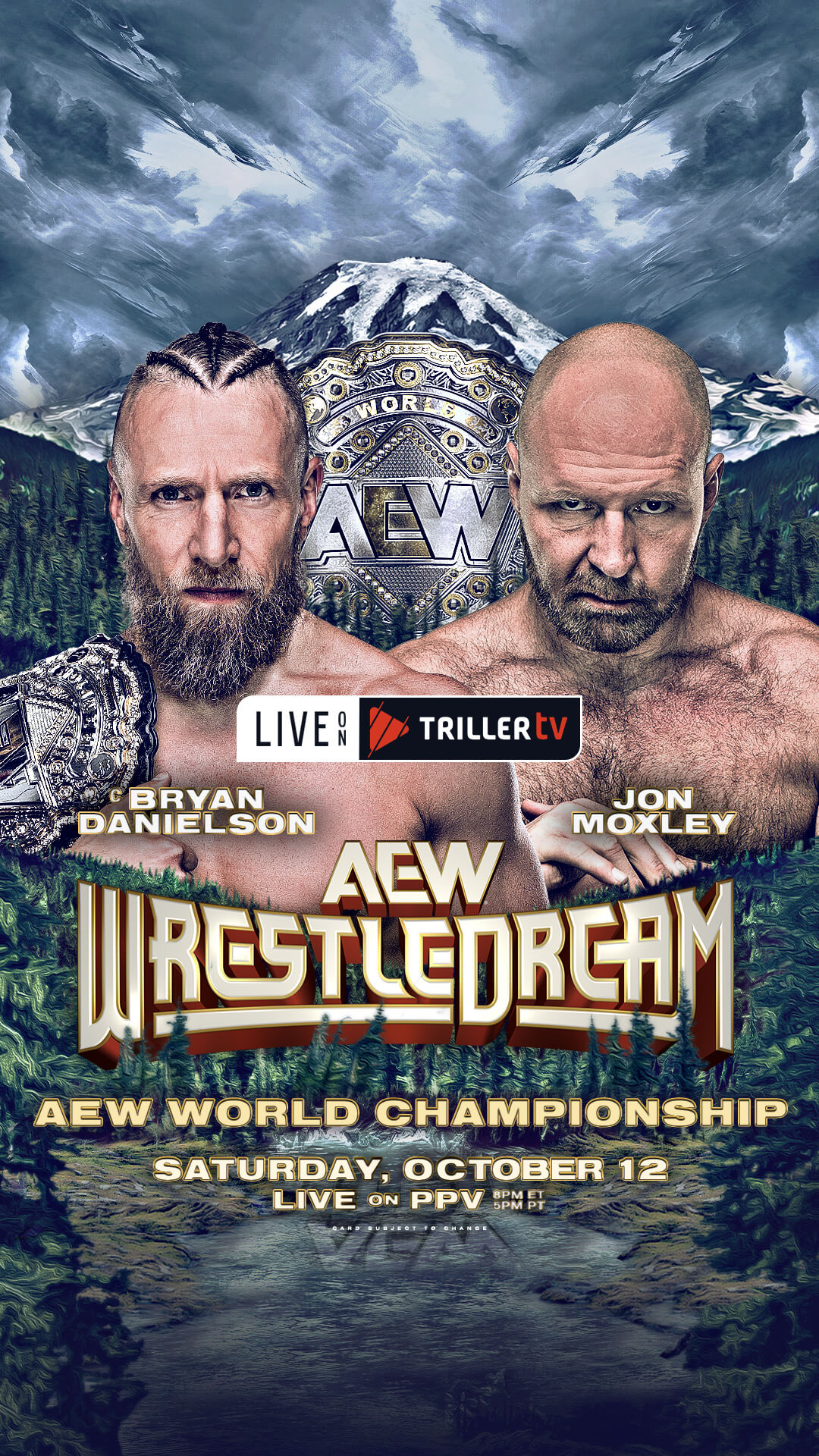REAL NAME: Paul Pellerin
BORN: June 8, 1941 in Shediac, New Brunswick
5’8 1/2″, 235 pounds
AKA/NICKNAMES: Paul Peller, Spider Galento, Black Spider
The Maritimes are often talked about as a great destination for wrestlers — short trips and regular work, beautiful scenery, great people, low cost of living.
So it shouldn’t really be a surprise that Stompin’ Paul Peller called it home all of his life, and besides a few trips in the winter to Montreal or Calgary’s Stampede Wrestling, never really wrestled anywhere else.

Freddie Sweetan and Paul Peller as Stampede tag team champions. Photo by Bob Leonard
Home kept calling, as did his responsibilities running a bar in Moncton, N.B. “Some winters I wouldn’t go away because my two daughters were growing up. Some winters I’d stay here, but other winters I’d go,” he told SLAM! Wrestling recently.
Born Paul Pellerin in Shediac, N.B., he was working dance halls as a bouncer when he met East Coast wrestler/promoter Emile Dupre, who asked him to consider being a wrestler. “He asked me if I was interested. I wasn’t very interested because I didn’t know anything about it.”
Once he heard a little more about the life, Pellerin was intrigued, and went to work out with Dupre in an old candy factory close to Pellerin’s home. “It was hard-wood floors, eh. So after three days, I didn’t want no part of that because I could hardly get up in the morning. But little did I know that there was going to be a ring … But this is how they put you through it at first, to see if you’re going to like.”
Knowing that it was at least regular work, his parents accepted his decision. “I wasn’t working … all I was doing was bouncing in halls. So they were looking forward to me getting some sort of money, which at the beginning, the pays weren’t that big!”
Pellerin has good memories from his early days in the 1960s, wrestling the likes of Cowboy Len Hughes, Bull Montana and a young Rocky Johnson.
During a tour of Stampede, his name got inadvertently shortened and a nickname was coined. “Dave Ruhl in Calgary called me Paul Peller, Stomping Paul Peller,” he explained. “To tell you the truth, that gave me a little push to get going. Every time I got really well known in the Maritimes, it was good. I didn’t like it at first, but it grew on people and that’s what it’s all about.”
Getting away from home meant a chance to wrestle some new competition. “I started developing new skills. You learn as the experience comes along. I got to go to Montreal and wrestle guys like Toru Tanaka, (Bruno) Sammartino … [you] learned the different moves, how they do things. It’s all the little tricks that you kind of pick up every time you met someone different. Then it started going good because out in the Maritimes here, I started picking up names and popularity. Then you start getting involved and drawing big crowds. You start liking it.”
It wasn’t that the wrestling world didn’t offer him chances to travel to more places than Canada and Boston, it was that he didn’t jump when asked. “I turned down Japan, which I’m very sorry. I could have went a couple of times, but I turned it down because I didn’t think I was qualified, good enough. The Beast and them kept telling me this, why don’t you go, there’s a Japanese guy that wanted to send me.”
Peller recalled a few great feuds he had out East. “One I used to have some barnburners with was Johnny Fargo. I tell, you, we could tear a lot of places down. It was unbelievable. This kid was full of fire. When he wanted to really go, he really could make things happen.
“Me and Emile had some pretty good barnburners too. Emile, when he didn’t want to be lazy … He was lazy. Sometimes he’d just want to slouch there, but I could make him go. He was very good too.”
Peller had his favourite towns, too. “My favourite places were in Bridgewater, Nova Scotia, Berwick and Cape Breton area. I was really popular down there,” he said. They just caught on to me. There was always a lot of electricity in the crowd.”
He considers the one and only Andre the Giant to have been his mentor, having taught him a lot about wrestling and life in a short amount of time after their first meeting in 1978. “When he came down to Moncton, for Emile, I was the one that met him at the airport. From then on, he took me to Montreal, and I had good years with him.”
As far as career highlights go, Peller considers his tag team championship reign in Stampede in 1970 with Freddie Sweetan as his crowning achievement. “They gave us a chance and we proved it. By proving it, we started drawing big. We sold out four weeks in a row in Calgary and Edmonton. We had matches against the football player Bob Luce and Emile Dupre. We were drawing big.”
He credits the fact that Sweetan was from a neighbouring county in New Brunswick as to why the team worked. “Sweetan was a big guy. He was six-foot-three. He was a raw-boned kid. He was really rough looking. He was from Albert County down here. So I thought we had made the right combination.”
Another local kid from Ste-Marie-de-Kent, N.B. shook Peller’s very foundations in 1990, and made him realize that it was probably time to hang up the tights after 30 years in the business.
“One of my last matches was in St. Mary’s, New Brunswick against the Acadian Giant (AKA Kurrgan) … Here I was, I was almost 50 years old, and I was still in good shape and everything. When it’s time to call it quits, it’s time to call it quits before you get hurt. You’re not as agile as you used to be. There was a bunch of young wrestlers coming up. They’d go across the ring three times before you could do one turn, so it was time to pack it in.”
Peller promoted around the Maritimes with Stephen Petitpas in 1988-89, with little success. “It wasn’t drawing,” he explained. “The WWF was real strong at that time and we didn’t have TV. Once you don’t have that TV, you just go by posters and it’s very hard to promote that way.
“We had good ideas and everything but for some reason the people just wouldn’t buy it.
“That was the first year that the GST came out. We had to pay on the tickets, everything. It hurt everything. It was rough.”
Along with Petitpas, Peller helped train a few wrestlers like The Acadian Giant, Todd McPhee, and the little-known Soaring Eagle, of which both Peller and Petitpas speak highly. “He could never go over 180, he was small. He was unbelievable. That guy was a helluva little wrestler,” said Peller.
Petitpas echoed that. “He could fly. Unbelievable. I’d kind of put him in a middleweight division. He and Eddie Watts put on some tremendous matches. … you guys can fly like that — I’ll just watch!”
These days, Stompin’ Paul Peller can be found driving a taxi around Moncton. Like his wrestling days, it keeps him close to home.


